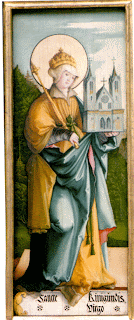Saint Frances of Rome
Foundress
Born at Rome in 1384, Frances was an exemplary wife and mother and dedicated her life to prayer and the assistance of the poor. She founded the Congregation of thr Oblates of Mary. She died in Rome in 1440 and was canonized in 1608. She is depicted in the black cassock and white veil of the Benedictines while distributing bread to the poor: She is often accompanied by a guardian angel. She is invoked against the plague and for the liberation of souls in Purgatory.
PROTECTOR: Car drivers and widows.
NAME: Frances (Frank) is of German origin, from the name of the people who settled in France; It has come to mean "forthright, sincere."
"SAINTS A Year in Faith and Art"
Rosa Giorgi











